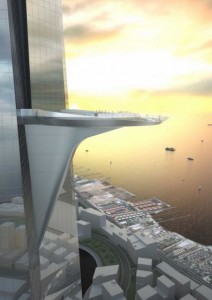By Whet Moser www.thenational.ae
Blair Kamin has an update on the Kingdom Tower, the proposed 3,280-ish-foot skyscraper designed by local starchitect Adrian Gill and planned for completion in 2017 in Jeddah, Saudi Arabia, at an estimated cost of $1.23 billion dollars (cheaper than the Burj Khalifa, a Gill project at SOM, thanks to low labor costs).

Kamin reports that structural engineering will be handled by a Chicago firm, the third associated with the project (Environmental Systems Design will be doing inside engineering, from plumbing to acoustics).
It’s exciting, except for the likelihood that the Kingdom Tower will be the end of the world, or at least the world economy:
In 1999, Andrew Lawrence, a research director at Deutsche Bank, created the “skyscraper index,” which showed that the world’s tallest buildings have risen on the eve of economic downturns. The Singer Building and the Metropolitan Life Building, completed in 1908 and 1909, respectively, heralded the depression of 1907–10. The Chrysler Building opened its doors in 1930, a year after the 1929 stock market collapse.
The fall of a great company, too, often coincides with the construction of an imperial headquarters. Gordon Metcalf, former chairman of Sears, had clearly lost any sense of perspective when he told the crowd at the opening of the 110-story Sears tower in 1973, “Being the largest retailer the world, we thought we should have the largest headquarters in the world.” He seemed oblivious to the fact that Sears was under attack from a new crop of retailers like Kmart and Penney. Around the time the tower was completed, Sears’ stock began a long downward slide.
The Skyscraper Index should be taken with a huge grain of salt—it started as a joke—but at the very least it’s an interesting tour through the history of architecture and financial disaster, done in detail by Austrian School economist Mark Thornton:
Also, it is worth noting that the completion of the Masonic Temple in Chicago (the first building to exceed 300 feet) in 1892 was preceded by the beginning of the largest swing (contraction) in recorded US history, culminating in the largest quarterly decline in real GNP in our history and was followed by the Panic of 1893.
But the idea behind it is intriguing: when the economy gets stupid, people start wanting to build the tallest buildings ever: More info














